Omnichannel Ecommerce Strategy: Benefits, Challenges, & Best Practices
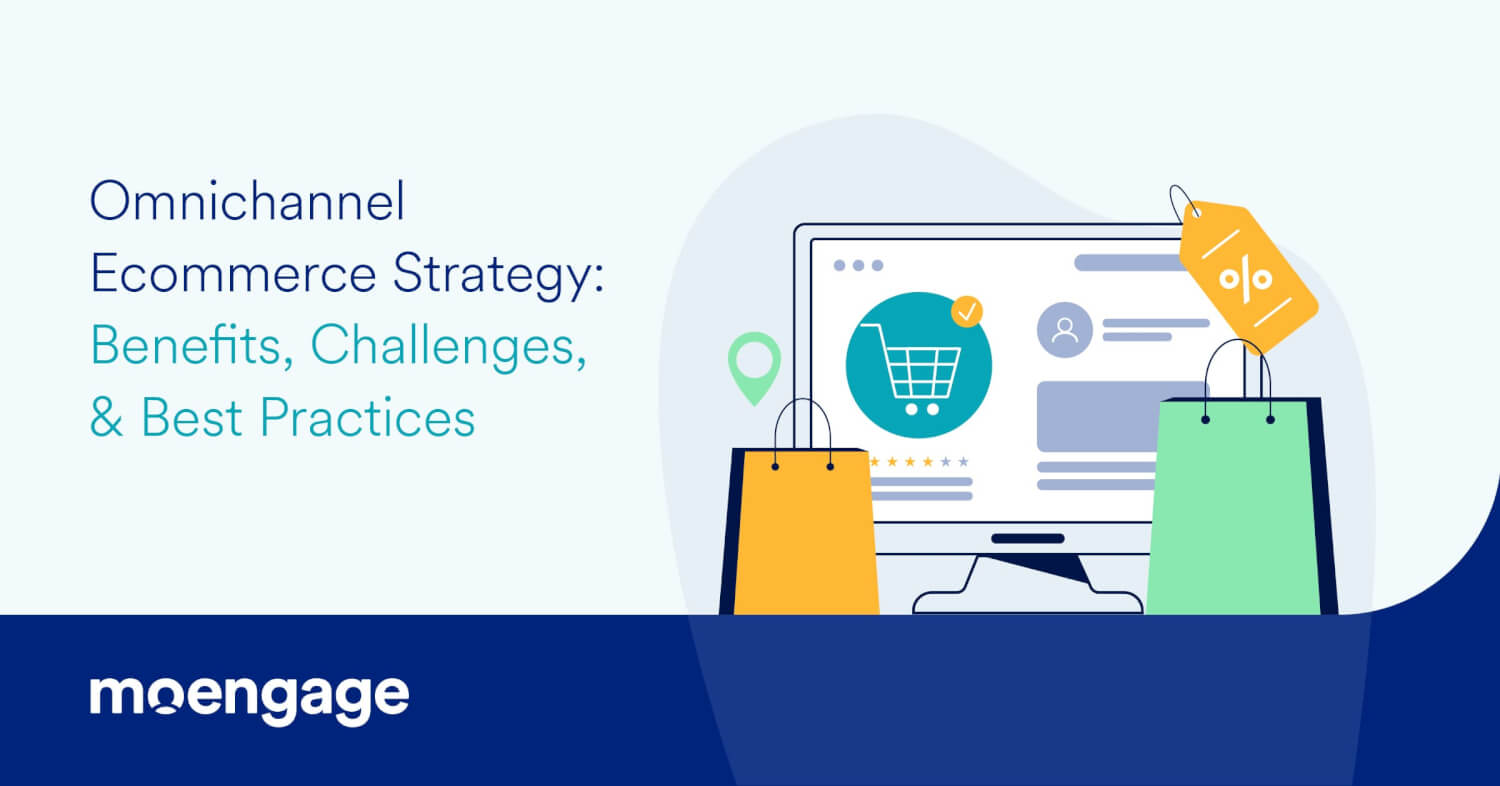
Reading Time: 11 minutes
Omnichannel ecommerce strategy allows brands to build a seamless shopping experience for their customers across various channels like mobile apps, websites, SMS, email, social media apps, and physical stores.
As customers use various channels to shop, a well-planned omnichannel ecommerce strategy can help brands improve customer experience across all channels, retain customers, and boost sales and revenue.
In this article, we’ll explore what omnichannel marketing is, the state of digital shopping, and how to master omnichannel ecommerce strategy to improve customer engagement.
This will help you understand the omnichannel ecommerce strategy in-depth and learn a few strategies that you can implement to improve customer experience and grow your business.
What is Omnichannel Marketing in Ecommerce?
Omnichannel marketing is used in the ecommerce industry to create and maintain a brand’s presence across multiple offline and online channels. It integrates various touchpoints like websites, mobile apps, email, SMS, and push notifications to send personalized messages and maximize conversions.
It is important because every customer interacts with the brand in different ways. Some might prefer ordering online and picking it up from a store, while others might browse a product in the store and get it delivered to their home.
Omnichannel marketing helps you create a seamless customer experience across offline and online channels. It brings all these channels together to create a continuous customer journey, drive sales, and build a meaningful experience for customers.
With the right strategy and technology, you can integrate all the channels seamlessly, bring consistency in messaging, and personalize and improve customer experience.
5 Omnichannel Ecommerce Trends: The Current State of Digital Shopping
Jeff Bezos, the former CEO of Amazon, once said that yesterday’s “wow” quickly becomes today’s ordinary. Market trends and customer needs keep changing. This is why you must know your customer’s expectations while planning your omnichannel ecommerce strategy.
Here are the top five ecommerce trends shaping the current state of digital shopping, and which you need to be mindful of when planning your omnichannel ecommerce strategy.
1. M-commerce will make up 44.6% of total ecommerce sales
According to eMarketer’s November 2023 forecast, m-commerce makes up 44.6% of total ecommerce sales in the US. The proliferation of social media apps and smartphone devices has made online shopping convenient. Customers prefer using mobile devices to shop instead of desktops as they can shop from anywhere, anytime.
2. 53% of North American shoppers visit an app three times before making a purchase
According to our Global Consumer Trends Report, 53% of North American shoppers visited an app or website more than three times before purchasing something. The reasons for this careful consideration could be many, from just checking and comparing prices to waiting for the prices to drop.
3. Customers prefer online shopping to visiting a physical store
Call it a behavior shift during COVID-19 or the flexibility and convenience offered by online shopping; our report shows that 55.8% of shoppers prefer shopping with smartphones to visiting a physical store. Online shopping lets customers compare product prices, research the product thoroughly, and order it with just a click.
4. Generalized communication and irrelevant messages frustrate customers the most
Customers expect hyper-personalized experiences and communications from ecommerce brands. According to our Personalization Pulse Check 2023 report, 31.9% of customers expressed frustration at receiving too little or too frequent communication, 19.9% said they did not receive timely updates from a brand, and 13% were disappointed that the brand did not remember their preferences or previous purchases.
5. Customers are comfortable sharing their information in exchange for personalized experiences
According to the Personalization Pulse 2023 report, 67.2% of customers said they were comfortable or slightly comfortable sharing their personal data, such as name, location, and e-mail ID, with the brand in exchange for a personalized experience.
Why Take an Omnichannel Approach to Ecommerce Customer Engagement?
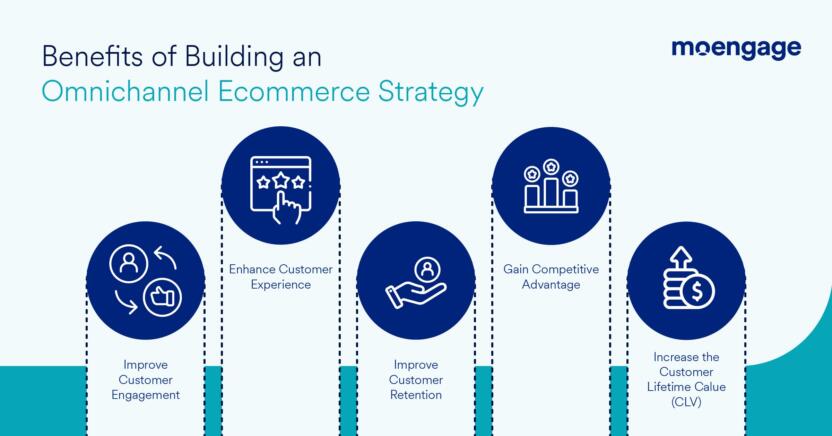
While brands use many channels to engage with customers, a siloed approach could lead to a poor customer experience. That’s why an omnichannel e-commerce strategy is so significant to a brand’s growth. Brands that don’t adopt an omnichannel e-commerce strategy could face challenges like high customer churn, low engagement, poor customer lifetime value (CLV), and a decline in conversions and revenue.
On the flip side, omnichannel ecommerce strategy takes a more integrated approach. It connects all the channels to create a seamless customer experience. It allows smooth data exchange between all the touchpoints, making it easy for the brands to understand their customers and personalize the experience.
Improve customer engagement
When all channels are connected, brands gain better visibility into the customer’s journey, preferences, and buying behavior. This enables them to send contextually appropriate messages to the customer at the right time, leading to better engagement.
For example, you can use omnichannel workflows to send reminder emails or special discount notifications to customers who abandon their carts after adding products. Then you can follow this up with a similar push notification in a few days, in case they don’t take any action.
Enhance customer experience
Traditional retail and ecommerce strategies were not designed to support dynamic customer journeys. As a result, brands that deployed these methodologies were not able to offer a cohesive experience to customers, especially when customers moved back and forth between devices and channels.
On the other hand, an omnichannel approach stitches all the channels together and ensures no interruptions in customer experience. It provides a consistent and smooth experience across all touchpoints.
For example, customers don’t have to start the shopping process from scratch when they switch between a smartphone and a desktop. They can continue shopping where they left off without any interruption.
Improve customer retention
Customers get frustrated when brands don’t understand their preferences and send contextually irrelevant messages at the wrong time. They will stop engaging with your brand if you don’t hyper-personalize the communication.
An omnichannel ecommerce strategy can solve this problem. It will help you understand your customers’ preferences and behavior and make brand interactions more relevant for them.
For example, if your customers prefer engaging with your brand during lunch hour, consider sending them push notifications at that time instead of late at night. You don’t want them to mute your messages if they disturb their sleep.
Gain competitive advantage
Creating a unique brand identity becomes important with so many ecommerce brands vying for the customer’s attention. This is when you have to go beyond the usual spray-and-pray marketing approach and embrace personalization. An omnichannel ecommerce strategy can help you personalize every interaction with the customer across all touchpoints based on their journey and shopping preferences.
Take Zumiez, for example. This US-based specialty clothing store ranked the highest in 2017 in the Top 100 Omnichannel Retailers report for its omnichannel experience. Zumiez allows customers to switch effortlessly between different channels, pick products ordered online from the store, earn loyalty points, reach out to customer service, and return merchandise in multiple ways.
Increase the customer lifetime value
Omnichannel marketing helps foster long-lasting relationships with customers and increase their CLV. CLV is a metric that measures the total revenue a brand can generate from a customer over the course of their engagement.
With omnichannel marketing, you can continuously engage with customers across different channels, tailor messages to engage with them continuously, and deepen their interest in your brand.
For example, you can send personalized emails about the products that might interest the customer or give them exclusive early access to new products relevant to their preferences, to strengthen the bond and improve customer loyalty.
6 Consumer Engagement Challenges in Ecommerce Marketing
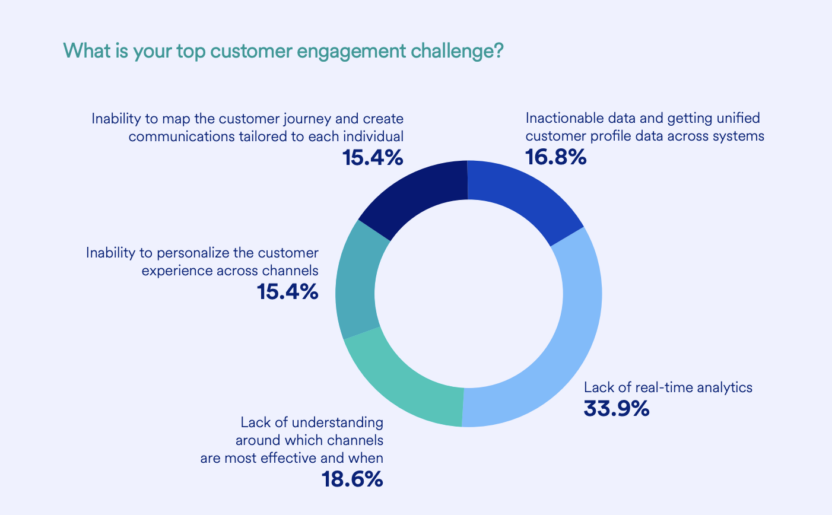
Despite knowing the benefits of omnichannel ecommerce marketing, many marketers struggle to execute these strategies for a number of reasons.
1. Lack of real-time analytics
According to The State of Insights-led Engagement Report, Over 33% of North American marketers admit that a lack of real-time analytics stops them from realizing the full potential of omnichannel ecommerce marketing. You cannot personalize experiences or send the right message at the right time without this data.
2. Lack of understanding of the most effective channels
While marketers understand the significance of reaching customers through their preferred channels, they struggle to identify the most effective ones. Over 18% of marketers face this issue. You could lose an opportunity to convert customers by not leveraging the most effective marketing channels.
3. Lack of unified profile data
Over 16% of North American marketers say that inactionable data and getting unified customer profile data across systems is their top challenge. Without a unified customer profile, you cannot successfully implement an omnichannel ecommerce strategy.
However, with so many channels involved, you might face challenges in gathering customer data from all touchpoints, analyzing the data, and building personalized omnichannel ecommerce marketing campaigns.
4. Inability to personalize the customer experience
According to the Personalization Pulse Check 2023: North America report, 32% of North American consumers said they would switch brands if the current brand’s communication was not related to their current shopping behavior. Personalization has now become a necessity for a brand to grow and thrive.
But, 15.4% of marketers say that personalizing the customer experience across different channels is their number one challenge. This happens when you cannot access holistic customer profiles, segment them, and personalize campaigns at scale.
5. Inability to map customer journeys and create tailored communication
To create tailored communication, you must understand the customer’s journey and map the messages accordingly.
Unfortunately, 15.4% of marketers find mapping customer journeys to create tailored communication their biggest challenge. This happens when you have limited visibility on the customer’s journey or have not planned for the dynamic shopping patterns. This might cause you to miss out on crucial trigger moments like drop-offs or micro-moments where the customers show high buying intent.
6. Repetitive mobile engagement efforts
Customers get exasperated when you bombard them with continuous and irrelevant messages. Every message you send must be unique and sent at a time that’s relevant to them.
To avoid sending repetitive, spammy messages, you must use AI-powered automation tools that not only help to optimize the customer journey but also provide personalized copy suggestions based on different use cases.
How to Master Omnichannel Ecommerce Strategy to Improve Customer Engagement
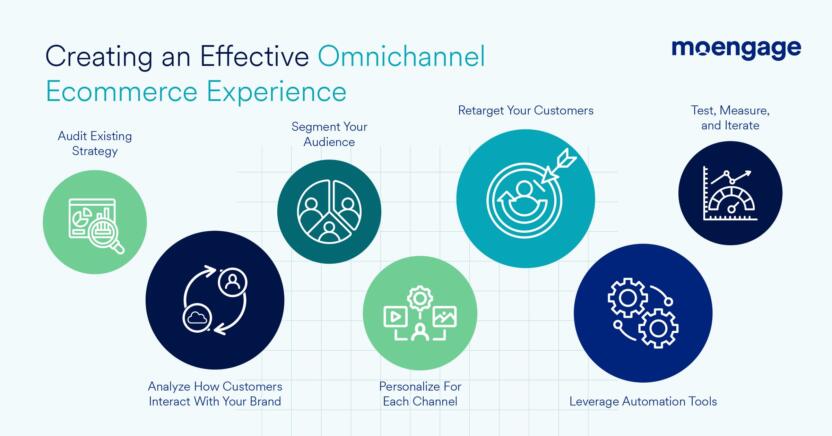
Now that you understand the challenges, let’s talk about how to solve them with a well-planned strategy. Here’s a step-by-step rundown of the best practices you can implement to master customer engagement using a little help from a platform like MoEngage.
1. Audit your existing ecommerce omnichannel marketing strategy
Audit your existing omnichannel marketing strategy to identify the gaps and decide on the improvements you can make to perfect it.
Monitor channels like social media and review sites and gather customer feedback to find areas of improvement and fix your strategy. Additionally, adopt a customer-centric mindset to enhance the strategy.
For example, if customers abandon the cart after adding the products, check the checkout process like a customer. You might find issues like a complicated ordering process and simplify it with solutions like one-click checkout to help customers shop without hassles.
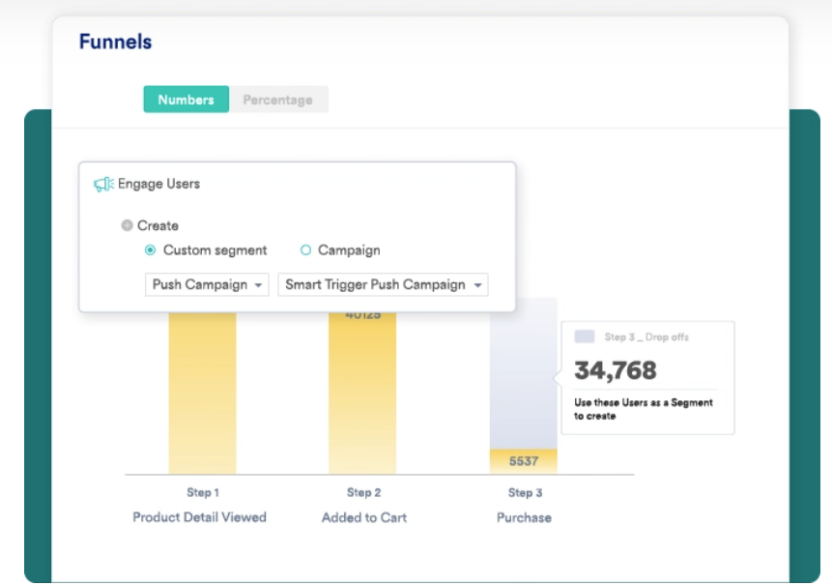
Tools like MoEngage have analytics that provide real-time actionable insights to help you identify bottlenecks, such as the reasons for low engagement or uninstalls, and personalize the experience to improve engagement.
2. Analyze how customers interact with your brand
Apart from understanding your customers’ demographics, analyze how they interact with your brand and arrive at the purchasing decision, and what channels they use and what are the friction points. This will help you understand what works well and what needs fixing, enabling you to improve customer experience.
MoEngage’s Channels allow you to engage with your customers across various channels based on your campaign goals. Using attribution data, you can identify the most effective channels and further improve campaign outcomes.
For instance, if the objective was to encourage customers to add a product to their cart, the attribution data will indicate how the customer added the product and whether it was through clicking on a push notification or when they were already using the app.
Insights like these will help you identify the channel with the highest engagement and use them to build a winning omnichannel ecommerce marketing campaign.
3. Segment your audience
To personalize communication and customer experience, you must segment your customers. You can segment your customers based on various criteria like demography, likes and preferences, online behavior, and more. This will help you understand your customers more deeply, and plan targeted marketing campaigns to improve engagement.
For example, the marketing campaign for a new customer will be different from an inactive customer’s. For a new customer segment, you’ll send emails with step-by-step videos or give an in-app tour to help customers make the most out of the app.
For the inactive customers segment, you can send emails with updates on new product features or give them special discounts on products they brought frequently to entice them to shop again.
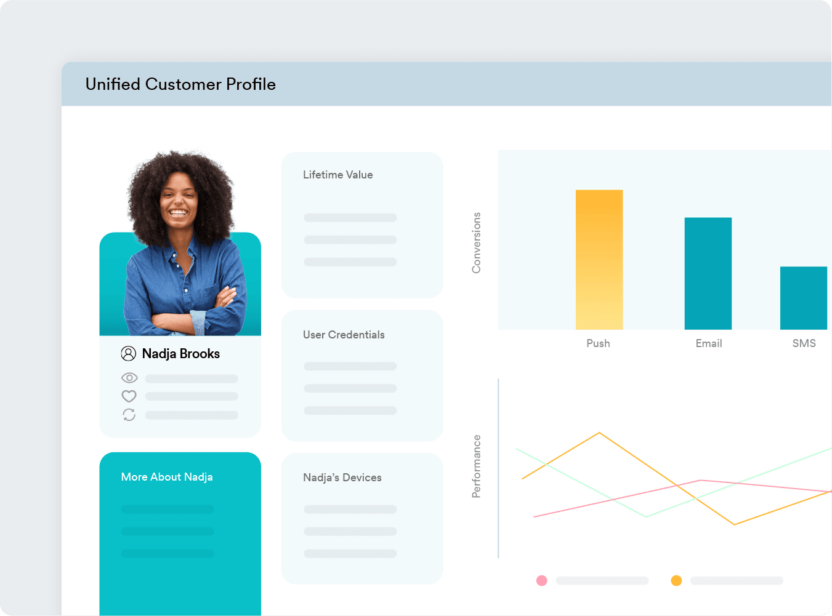
MoEngage’s Omnichannel Marketing Platform gathers and unifies customer data in one place, giving you a 360° view of each of your customers. It allows you to create hyper-personalized campaigns for each customer and increase conversion rates.
4. Personalize the content for each channel
Although omnichannel marketing aims to offer a consistent experience, the content must differ for each channel.
For example, you cannot use your email content for push notifications or SMS, as it is more detailed. On the other hand, the content for push notifications and SMS messages must be concise and rich with graphics.
A best practice would be to use data to understand how each channel functions and spend time crafting personalized content to maximize engagement. MoEngage helps you achieve this by unifying customer data so you can compare interactions across channels, build customer segments, and send personalized campaigns for things like cart abandonment, product recommendations, and more. This helps you to personalize customer experiences.
5. Retarget your customers
Most customers prefer comparing prices and researching options from different websites, especially when they are buying an expensive product. Hence, creating a top-of-the-mind recall is crucial.
Re-targeting is a good strategy to use in an omnichannel e-commerce marketing strategy. It allows you to create personalized re-targeting journeys for customers across different channels.
Let’s take an example of a customer looking to buy an expensive gadget from your website. They will browse through your website, add the gadget to the cart, and compare the prices with other websites. To ensure top-of-the-mind recall, you can use re-targeting to nudge them to buy the product.
Inside MoEngage, You can send them a reminder email with product details and customer reviews and do website retargeting to display the gadgets on websites they browse. This seamless and cohesive messaging across all channels will reduce cart abandonment and improve conversions.
6. Leverage automation tools
Use automation tools to send personalized content to the right customer at the right time and on the right channel. Automation tools will help you segment customers smartly, understand customer journeys, schedule campaigns, and send personalized messages to customers across all touchpoints. Ensure you choose the right automation tool to improve conversions and enhance customer experiences.
MoEngage’s Customer Journey Orchestration can help brands craft unique experiences and automate campaigns across all platforms using Flows. You can set up campaigns for each customer journey stage – from onboarding to engaging with customers in just a few minutes. You can also leverage AI to analyze and guide the customer on the best-performing path.
MoEngage’s AI-powered Sherpa and Generative AI engine Merlin AI eliminate all the guesswork from marketing. They help you adapt to changing customer behavior, create impactful campaigns by understanding the audience, context, and past campaign performances, and ensure the right message is sent to the customer at the right time.
7. Test, measure, and iterate
A/B testing allows you to test different variations of your campaigns. For example, you can test small changes to things like designs, CTAs, and copy in a controlled way while running a campaign. Simultaneously, you can experiment with the journey flow and message-sending time.
This will help you determine what resonates the most with the customer and iterate your campaigns to make them more effective. It removes all the guesswork from omnichannel ecommerce strategy, increases click-through rates, and improves the chances of conversion. It will help you create more personalized and engaging experiences for your customers.
| Want to know how your peers are implementing their omnichannel ecommerce strategy? Read the State of Ecommerce & Retail Cross-Channel Marketing to find out |
Conclusion: Why You Need an Omnichannel Ecommerce Strategy
Providing customers with a seamless and personalized experience across various channels is essential to deepening brand loyalty, driving sales, and achieving success.
An omnichannel ecommerce strategy can help you create a seamless and personalized customer experience across all channels and improve customer engagement and retention.
With the right tools, like MoEngage’s Omnichannel Platform, and a good strategy, you can build successful omnichannel marketing campaigns for your brand and grow your business to the next level.
To know more about our solutions, request for a live demo.








